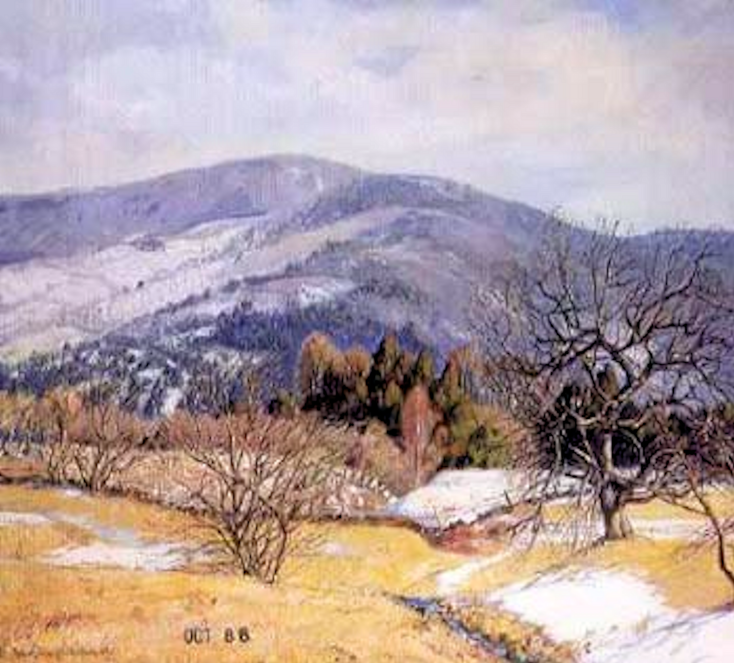Quick Reference
Painted in1938
Of Putts Hill from Orcutt Hill
Buckland Center, MA
Oil on Canvas
Landscape
Landscapes & Views
27" x 30"
Williston Academy, 1936, '37, '45
Harlan Miller, 1937
Winchester AL, 1937
Mass. State College, 1938
Valleyhead Sanitarium, 1938
MacBeth Galleries (NYC), 1939, '41
San Francisco Bay Exposition, 1939
MacBeth Galleries (NYC), 1942, '44
The Guild of Boston Artist, 1943
Home of Mr. & Mrs. Roger Smith, '44
Kastoff's Gallery, 1946
Dr. and Mrs. B. T. Guild
N/A
Related Links
- See also the...
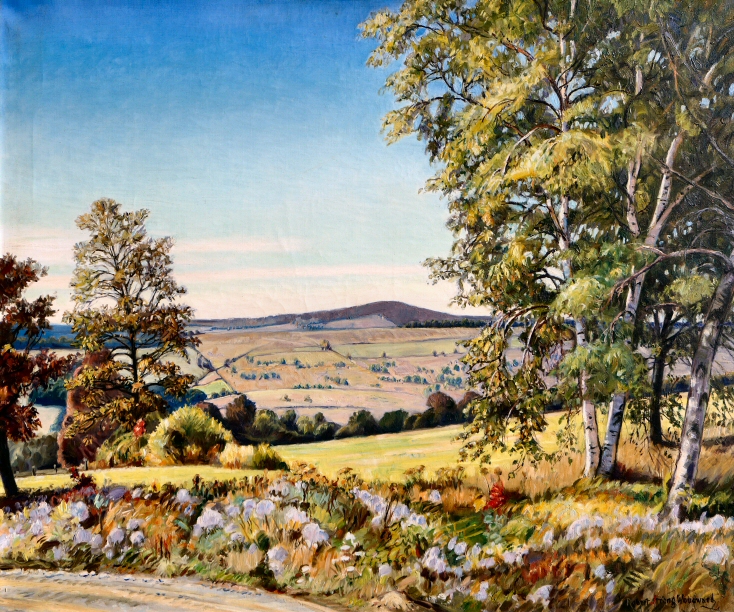 Landscapes & Views Gallery to view related pieces.
Landscapes & Views Gallery to view related pieces.
- See also the...
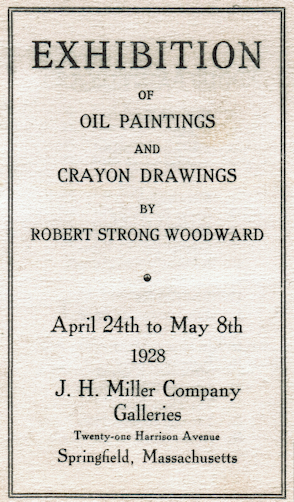 Exhibition List for a complete list
Exhibition List for a complete list
- See our page devoted to ...
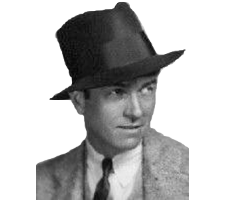 RSW friend and Hollywood Interior Designer Harold Grieve
RSW friend and Hollywood Interior Designer Harold Grieve
- See also the...
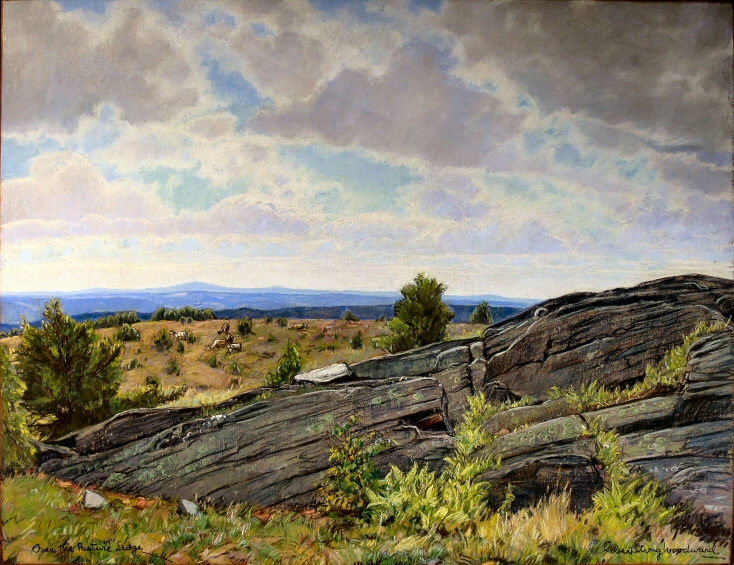 Rocks & Stone Walls Gallery to view related pieces.
Rocks & Stone Walls Gallery to view related pieces.
- See also the...
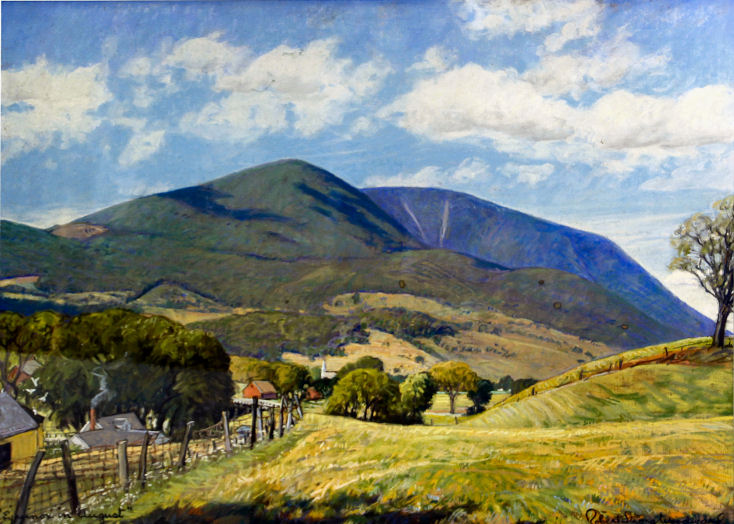 Mountains Gallery to view related pieces.
Mountains Gallery to view related pieces.
- See also RSW's ...
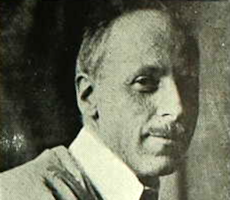 Personal Friends Gallery
Personal Friends Gallery
- See also the...
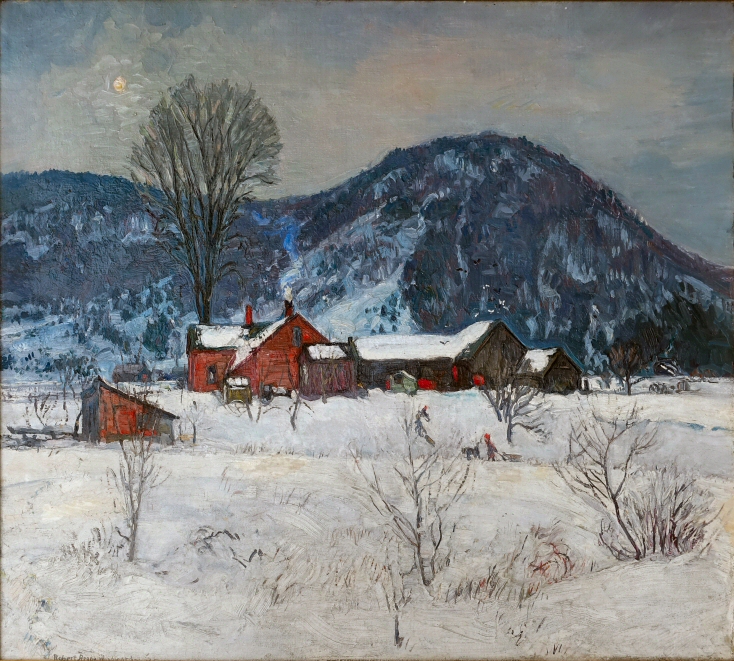 Purinton Hill for related pieces.
Purinton Hill for related pieces.
- See also the...
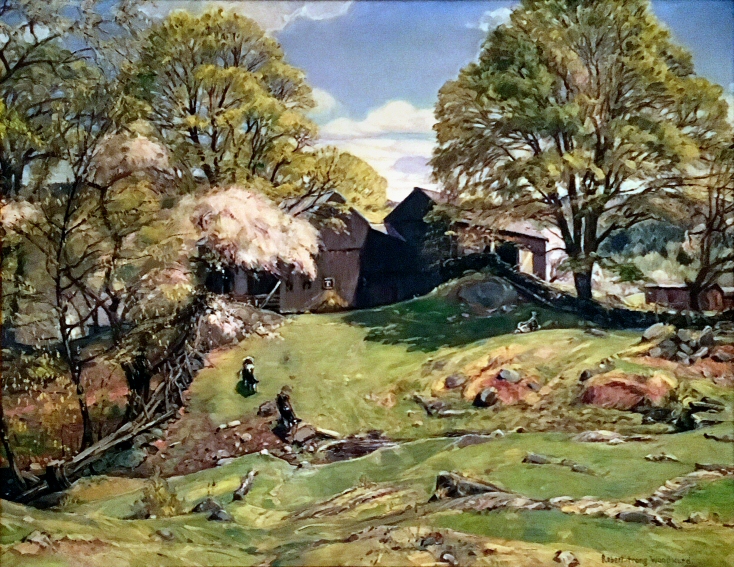 Pastures Gallery to view artwork.
Pastures Gallery to view artwork.
- See also RSW's ...
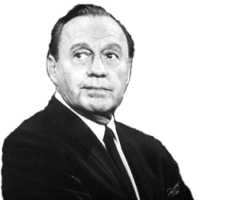 Famous Owners Gallery
Famous Owners Gallery
- See also the...
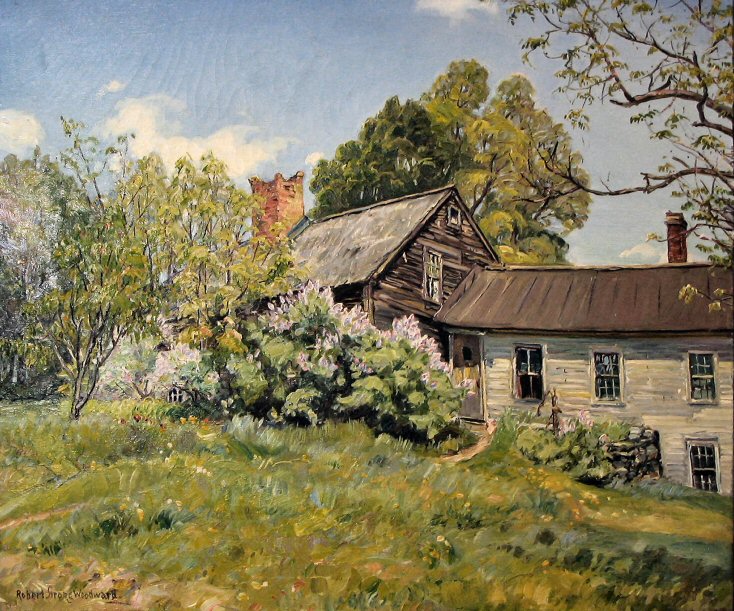 In Bloom Gallery to view related pieces.
In Bloom Gallery to view related pieces.
- For more about the...
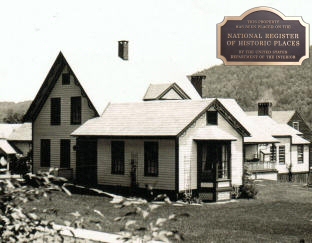 Southwick Studio, see our Scrapbook page.
Southwick Studio, see our Scrapbook page.
Featured Artwork: Winter Song
RSW's Diary Comments
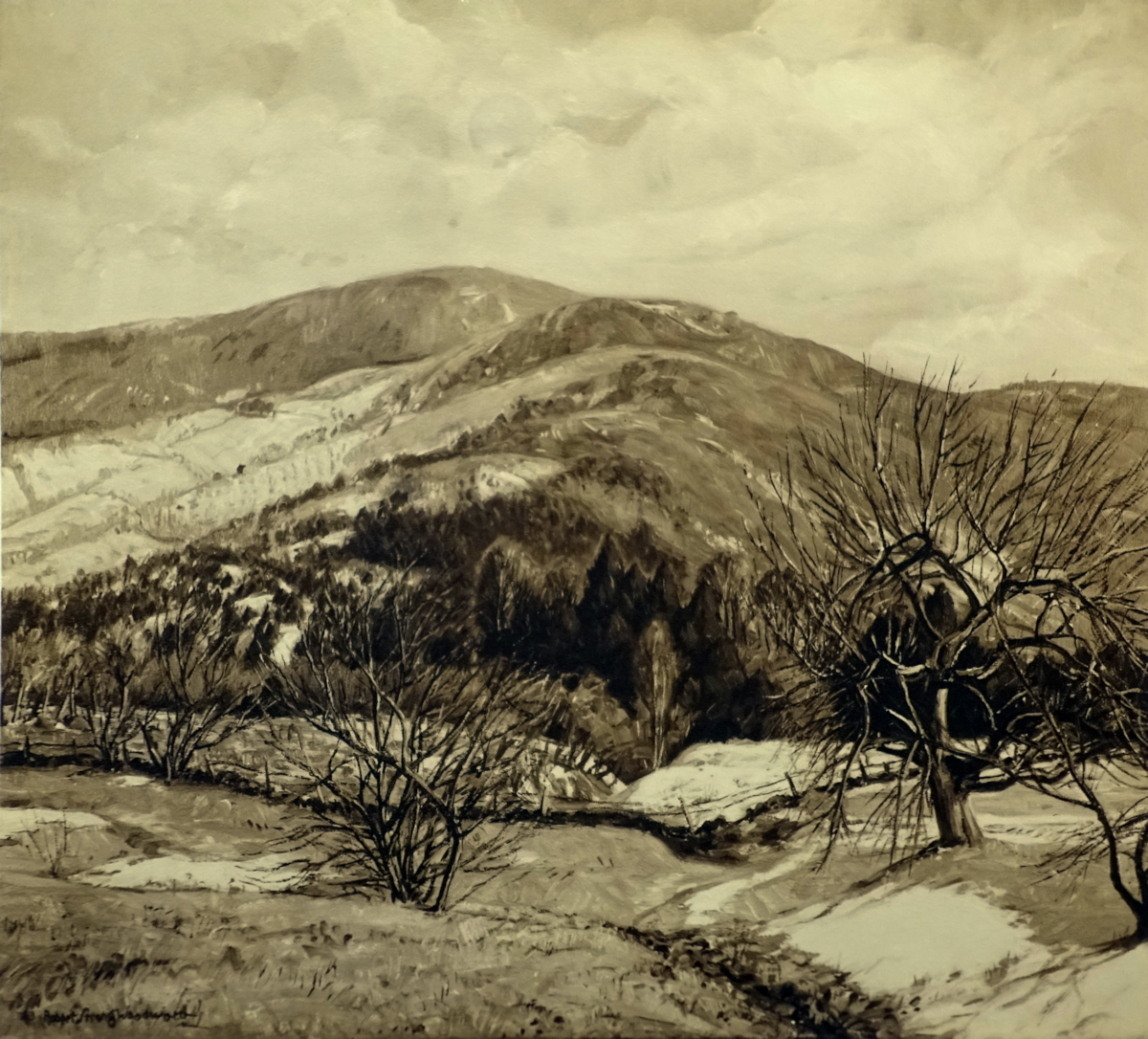
 Winter Song, Sepia
Winter Song, Sepia
"Painted in 1938. Painted in the late winter (or very early spring) from Orcutt Hill in Buckland. One of my most successful canvases. Foreground in 'open winter' effect with yellow grassland, and drifts and scrub apple at the edge of which is a band of forest and dark hemlocks, beyond which Putt's Hill [see editor's correction below] rises dramatically in grays and violets and light blues under a sky of white hazy clouds. Beautifully painted and designed. Exhibited about the country and at Golden Gate Exposition in San Francisco in 1939. Bought in summer of 1946 by Dr. and Mrs. B. T. Guild, Barkers Point Road, Sands Point, Long Island, N. Y. (At the same time they purchased The Chinese Lily which see.)"
Comments on the back of a sepia print:
Bought by Dr. and Mrs. Guild in the summer. Putts from Orcutt Hill, of course. One of my loveliest paintings. This canvas was out at the San Francisco World's Fair exhibition of American Art a few years ago. Mountain dull blue, yellow rose and violet in foreground between snow drifts
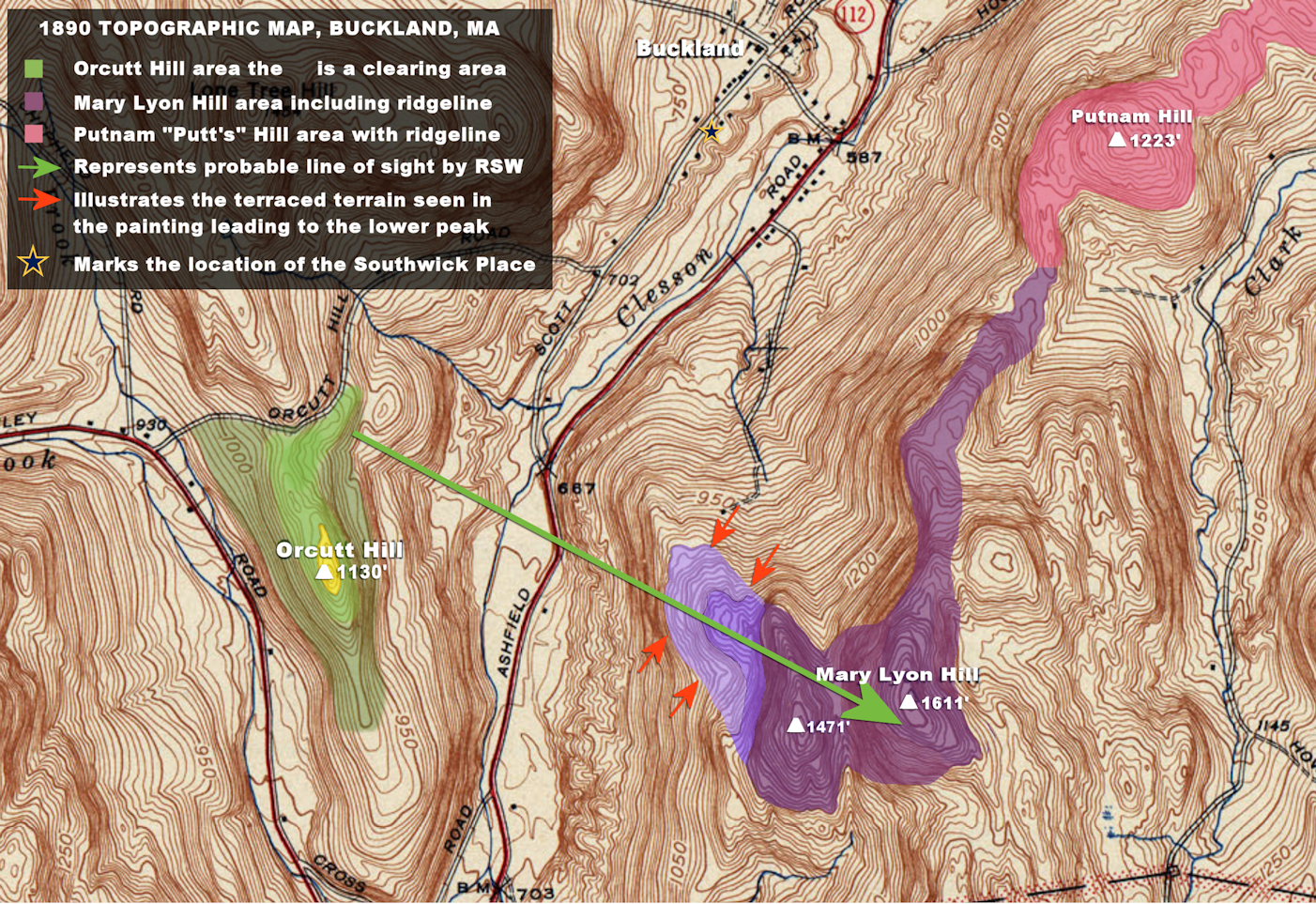
 A portion of a 1890 Topographic map of
A portion of a 1890 Topographic map of
Buckland, MA. Graphics were added to illustrate
the relationship of Orcutt, Mary Lyon, and Putt's hills
to each other, as well as, RSW's vantage point.
Editor's CORRECTION; not Putt's Hill:
Woodward, we believe, correctly recalled "Orcutt Hill" as the spot he painted this painting. However, the hill he painted are the double peaks of
Mary Lyon Hill. His mistake was not intentional. There just so happens to be quite a bit of confusion over the differences between Mary Lyon Hill and Putnam, Putt's for short, Hill,
even among people whom have lived there all their lives. There are some who assume that all the names apply to the same hill. We wonder if it is because Mary Lyon Hill has
twin peaks and the assumption is that one peak is Putt's and the other, higher peak is Mary Lyon.
This is not the case according to topographical maps of the
area from the late 19th and early 20th centuries. It is an honest mistake. The two hills do run concurrent to each other running north and south sharing a ridgeline. Still, Putt's
Hill is too far north from the vantage point of Orcutt Hill looking to the twin peaks of Mary Lyon Hill (1471ft and 1611ft respectively). Even if Putt's Hill was in the distance one
would hardly see it at all. It is more than 200 feet smaller than Mary Lyon Hill's smallest peak.
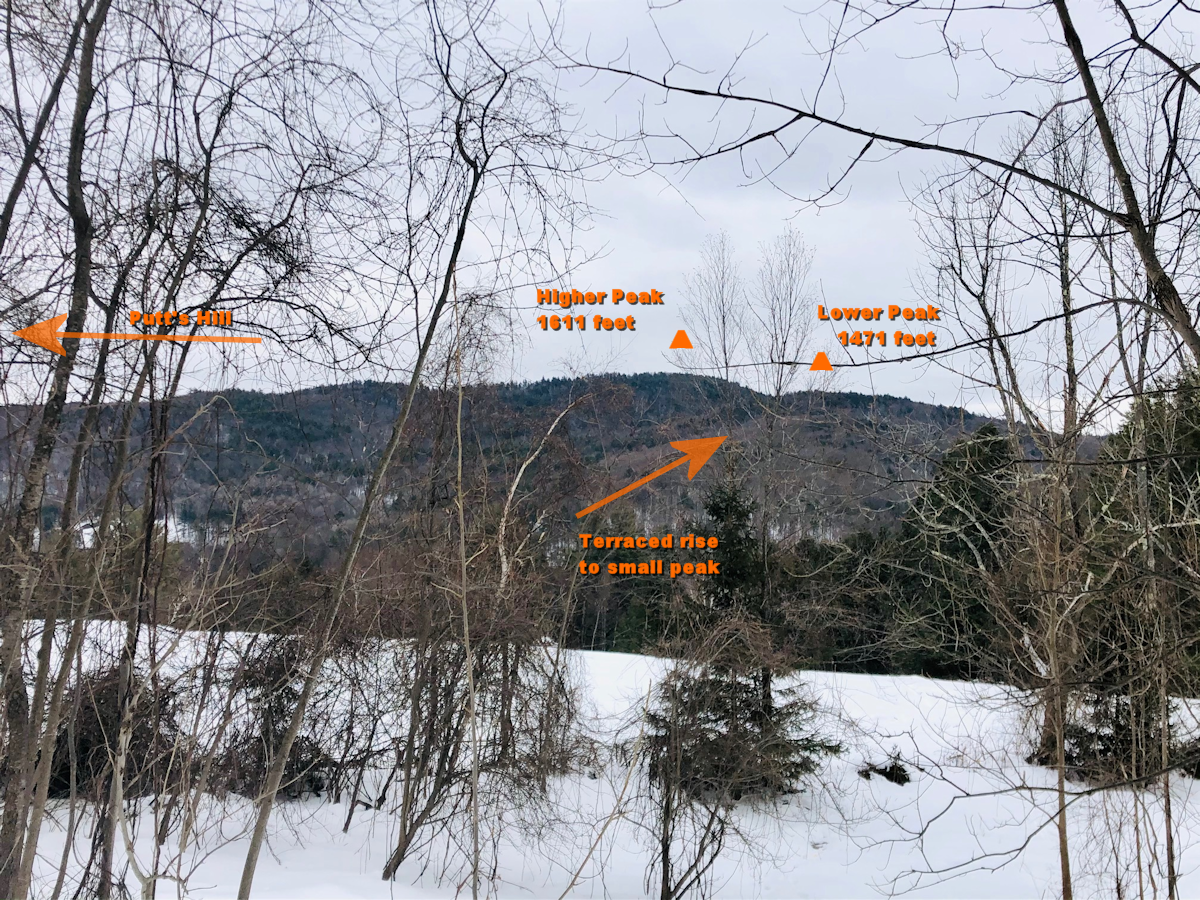
 Picture from Orcutt hill to Mary Lyon hill today
Picture from Orcutt hill to Mary Lyon hill today
Photo credit: Sally Spenser
The only real question that remains is this - Did Woodward paint this from Orcutt Hill Road or did he take the path out to a clearing near Orcutt Hill's peak? It is a coin toss but for illustrative purposes we chose the road in our topographic map seen to the left. The map illustrate all that has been discussed here and it will be clear upon examination that Putt's Hill is nowhere near (more than a mile north) the peaks of Mary Lyon Hill.
Editor's NOTE:
This painting was purchased from the 1944 Mr. & Mrs. Roger Smith Exhibition. A private exhibition of remarkable painting arranged by F. Earl Williams. Go to the bottom of this page for more...
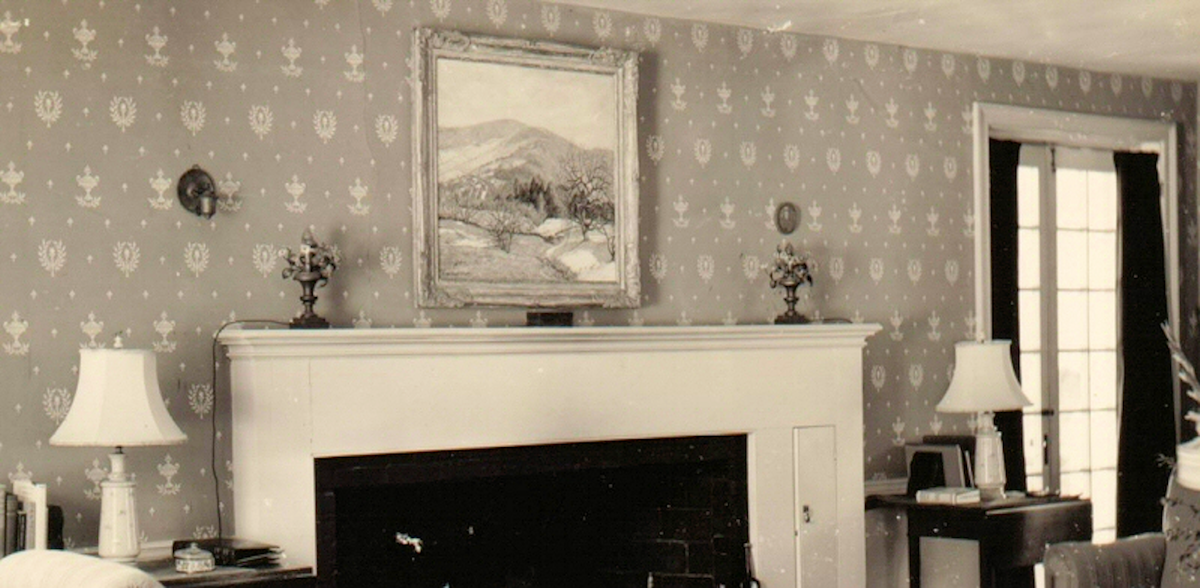
 Winter Song hanging in the home, above the fireplace, of B.T. Guild in Long Island (NY)
Winter Song hanging in the home, above the fireplace, of B.T. Guild in Long Island (NY)
Additional Notes
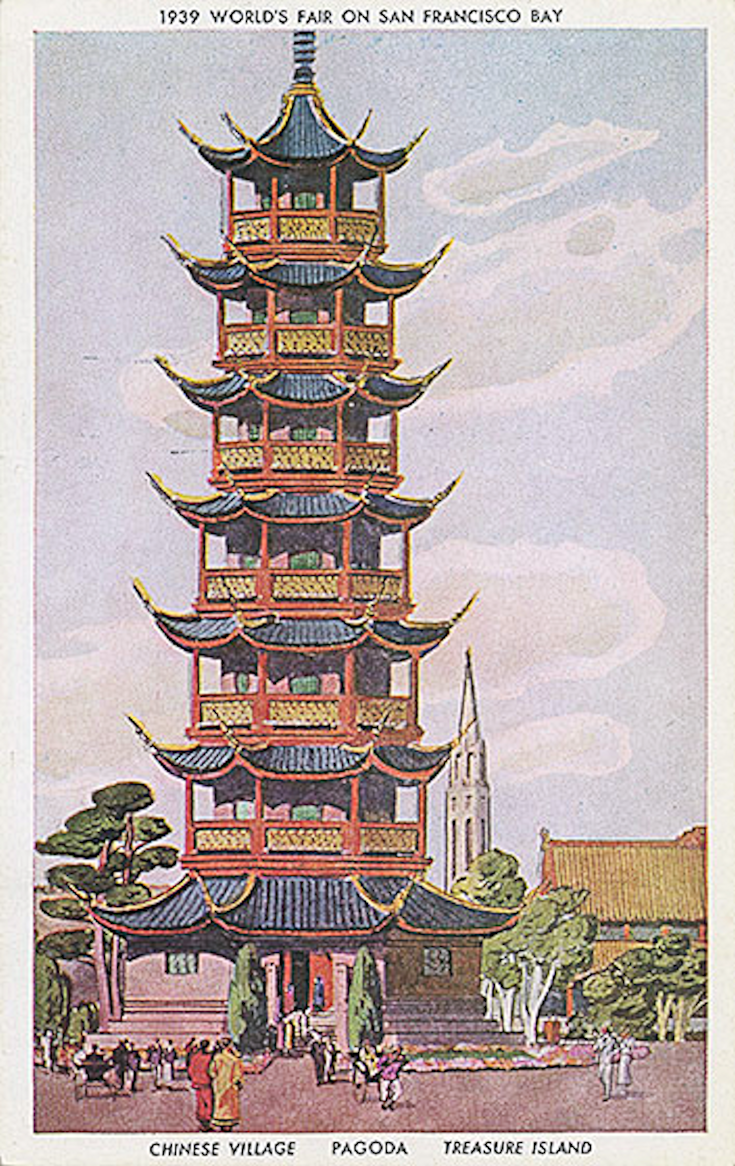
 Postcard of Chinese pagoda,
Postcard of Chinese pagoda,
in the Chinese Village from the 1939
Golden Gate International Exposition
 This painting was very special to Woodward. It served two purposes; (1) it gave him an opportunity to feature a composition in
a style much more appreciated in the eastern cultures that he very much admired and; (2) honored his beloved long time friend who he sent this painting to be hung at the 1939
Golden Gate International Exhibition (GGIE).
This painting was very special to Woodward. It served two purposes; (1) it gave him an opportunity to feature a composition in
a style much more appreciated in the eastern cultures that he very much admired and; (2) honored his beloved long time friend who he sent this painting to be hung at the 1939
Golden Gate International Exhibition (GGIE).
Technically a "world's fair" in many respects, GGIE's scope was not as much about technology as the traditional world fair.
The Golden Gate Expo was about trade with the east across the Pacific, such as Japan and China; giving "gate" a literal meaning. Descriptions of the event mention its cultural
displays of traditional crafts and trades performed in the east. Woodward valued the art of handmade craftsmanship that was being displaced by new manufacturing methods.
He also appreciated and admired the cultures and art of China and Japan. In many ways, he was greatly influenced by them, which is why we suspect he chose this painting to
send for the art exhibition.
It was his choice to send it to what was considered the west coast World's Fair held on Treasure Island in San Francisco Bay. It was also
held at the same time as New York's World Fair (1939) which naturally overshadowed it. In part, because the GGIE was shuttered early and taken over by the government as international
tensions grew at the outbreak of WWII as well as souring relations with Japan and the atrocities inflicted on China by the Japanese. Woodward sent a painting closer to his brand,
New England Impressions, to New York and San Francisco got this one.
---------------------------------------------------------------------------------------------------------------------------------
It maybe worth a mention that Woodward was deeply upset, baffled, and dismayed by Japan's brutality and ruthlessness. He never supported such cruelity, and at the same time found it so hard to understand how such seemingly simple, modest, and humble people could do such things.
---------------------------------------------------------------------------------------------------------------------------------
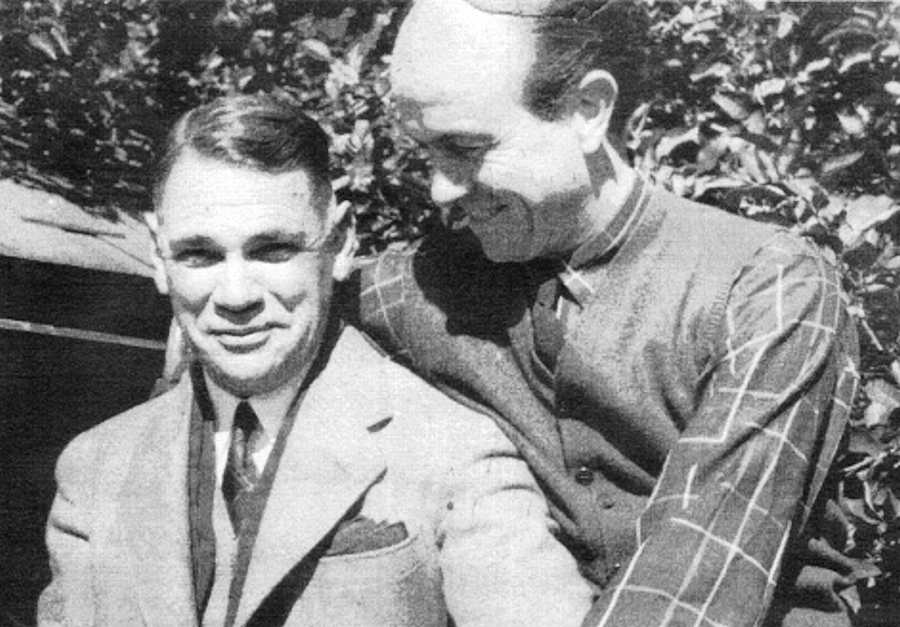
 Woodward being embraced by Harold
Woodward being embraced by Harold
on the balcony in the rear of the Southwick Studio.
Woodward's choice of featuring the spine of Mary Lyon Hill leading to its peaks is very much an eastern aesthetic. In the west, the front-face and majesty of a hill or mountain
are better admired and considered more inspiring. In the east, it is the simple, unassuming, and understated that is given great appreciation. Even the name, which is unusual for
Woodward to use a strictly poetic offering, has the feel of Japanese obfuscation from a haiku. We believe this was intentional to appeal to a different audience but there is another
reason this expedition was special for him.
The Golden Gate Expo's art exhibition was being curated by his close, personal friend, and former neighbor he met in Los
Angeles, Harold Grieve. Grieve was nearly 16 years younger than Woodward but they shared a tight bond. Grieve's father,
Alexander, was a butcher and aspiring politician. His butcher shop was located on East First Street in downtown LA close to where the Woodwards were living. We believe, the two
families became friends over the year before RSW arrived in LA and so young Harold would have known RSW just a couple months before his accident in September of 1906.
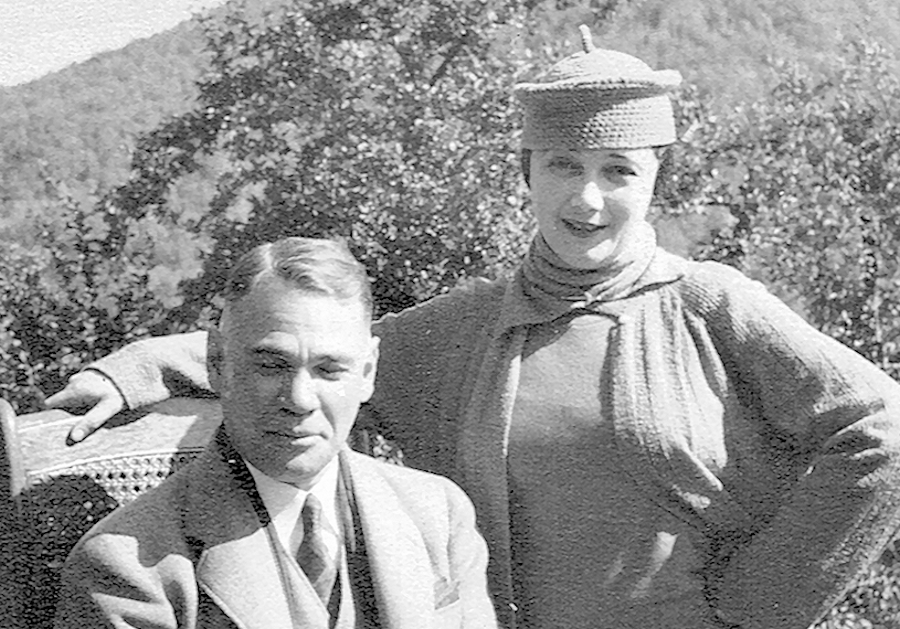
 Woodward and Jetta posing on the
Woodward and Jetta posing on the
balcony in the rear of the Southwick Studio.
Harold would grow up to initially work in set design for films in Hollywood, is a founding member of the Academy of Motion Picture of Arts & Sciences (The Oscars), and would later become a prominent interior decorator along with his famous wife, silent film star, Jetta Goudal, in Los Angeles. [Goudal once sued influential director Cecil B. DeMille for defamation of character after he blamed her for a movie being well over budget and delayed and won when DeMille refused to show his ledgers!] Harold was quite literally a pipeline for Woodward to Hollywood's elite and at the time of the GGIE, Harold was President of the California Interior Designers Association.
 We believe the picture taken of Harold and Jetta visiting Woodward in Buckland was taken after the Golden Gate International Exposition.
These pictures were taken from the studio balcony. The picture with Jetta is pointing north towards what really is Putt's Hill, sloping just above their heads across the Clesson River valley
which cuts through this part of Buckland.
We believe the picture taken of Harold and Jetta visiting Woodward in Buckland was taken after the Golden Gate International Exposition.
These pictures were taken from the studio balcony. The picture with Jetta is pointing north towards what really is Putt's Hill, sloping just above their heads across the Clesson River valley
which cuts through this part of Buckland.
Woodward tended to be a formal sort of guy. His picture with Harold differs from any other picture we have seen of Woodward posing
with friends. Harold is nearly on top of him, sitting in his lap, and arm affectionately around him. We cannot think of anyone else who would have "the nerve" to approach Woodward in such
a way other, than someone who knew him in a way most never had. They played tag together! they shared a mutual interest in art and design for which I am certain Woodward encouraged and
maybe even mentored Harold like only an older brother could. Harold, just five years old when they met did not fear Woodward's wheelchair or to approach him so closely. For us, the
pictureshows all that these two meant to each other.
The 1944 Mr. & Mrs. Roger Smith Exhibition:
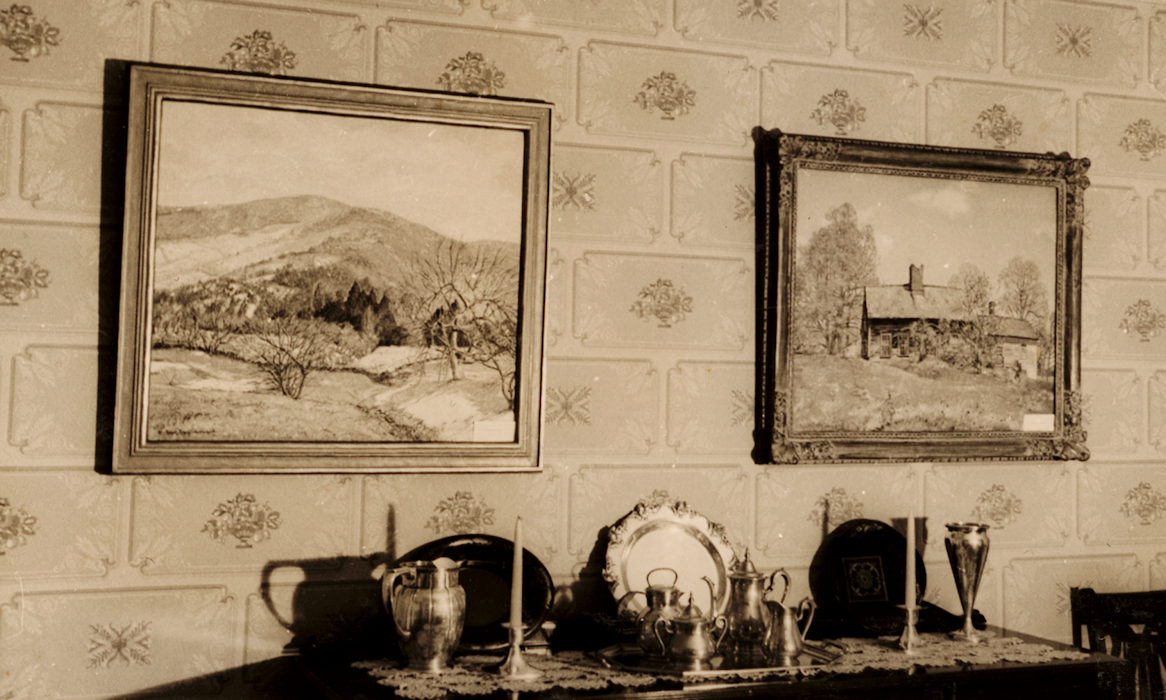
 Winter Song and The Big Chimney* hanging
Winter Song and The Big Chimney* hanging
in the home of Roger Smith for a private exhibition
 To the right: is a photograph of A Winter Song* and
The Big Chimney* hanging on the wall for a private exhibition in the home of Mr. & Mrs.
Roger Smith of Gardner, MA, December, 1944. The picture was taken by Woodward friend, educator, and amateur photographer
F. Earl Williams. Williams was once the principal of Gardner High School and so we believe he had something to do with
arranging this rare exhibition of Woodward's paintings in a private residence. The three missing photographs are New
England Impressions*, Winter Farms, and From the
North Window*. The paintings photographed are as follows in pairs: April Sun and
Frost on the Window, Portrait of a Shadow and
From a Mountain Farm*, there is the chalk drawing The Road Home
, the oil A Winter Afternoon and other chalk Mountain
Meadow together and then Tranquility, and The Little Red Barn*
as singles.
To the right: is a photograph of A Winter Song* and
The Big Chimney* hanging on the wall for a private exhibition in the home of Mr. & Mrs.
Roger Smith of Gardner, MA, December, 1944. The picture was taken by Woodward friend, educator, and amateur photographer
F. Earl Williams. Williams was once the principal of Gardner High School and so we believe he had something to do with
arranging this rare exhibition of Woodward's paintings in a private residence. The three missing photographs are New
England Impressions*, Winter Farms, and From the
North Window*. The paintings photographed are as follows in pairs: April Sun and
Frost on the Window, Portrait of a Shadow and
From a Mountain Farm*, there is the chalk drawing The Road Home
, the oil A Winter Afternoon and other chalk Mountain
Meadow together and then Tranquility, and The Little Red Barn*
as singles.
And what an exhibition! Worthy of any New York or Boston Gallery, it featured a number of Woodward's most exhibited editorial paintings going back as far as 1935 [noted by an
asterisk*] Two of the paintings hanging at the exhibit, A Winter Song and New England Impression previously hung at the 1939 Golden Gate
Exposition in San Francisco and the 1939 New York World's Fair respectively.

.png)

